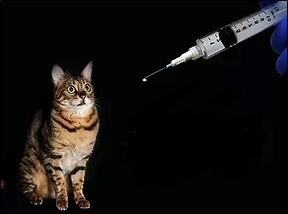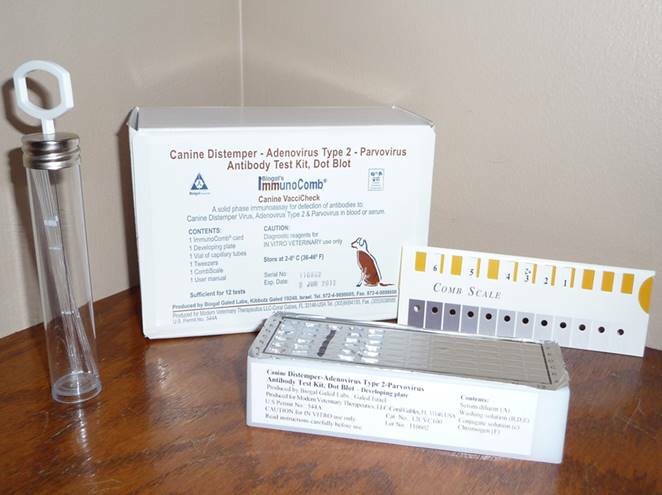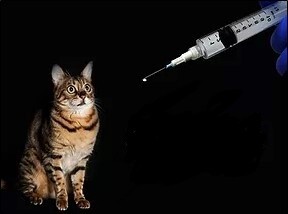
Demand Information before Consent
When the phenomenon of titer testing emerged, many veterinarians were concerned that their “bread and butter” vaccine income would diminish. Veterinarians, often resistant to change, were fearful to implement a new program about which they had no training. For the veterinarians who embraced this integrative approach, many rewards have been reaped! New clients flock to veterinarians who encourage titer testing and do not push excessive vaccinating! If you are a pet parent, you should support veterinarians who teach you how to make informed decisions for your individual pet.
When the phenomenon of titer testing emerged, many veterinarians were concerned that their “bread and butter” vaccine income would diminish. Veterinarians, often resistant to change, were fearful to implement a new program about which they had no training. For the veterinarians who embraced this integrative approach, many rewards have been reaped! New clients flock to veterinarians who encourage titer testing and do not push excessive vaccinating! If you are a pet parent, you should support veterinarians who teach you how to make informed decisions for your individual pet.
What is a Titer?
A titer test is good science. It is correctly spelled titre or titer. It is pronounced tight-er. It is a blood test that measures the antibody protection in your pet’s serum from the vaccines or natural exposure received in the past.
A titer test is good science. It is correctly spelled titre or titer. It is pronounced tight-er. It is a blood test that measures the antibody protection in your pet’s serum from the vaccines or natural exposure received in the past.
The first step toward the implementation of an effective titer testing program in a veterinary facility is to develop an understanding of what a titer is and to be able to explain this to clients in easy-to-understand terminology. The concepts of titer testing, core vaccines, and over-vaccinating go hand in hand. Today’s internet-savvy clients are aware of these topics and expect their pet’s veterinarian to provide them with current information and options. As a pet parent, you deserve to be told the benefits and risks of a given vaccination so that you can decide based on informed consent. For example, vaccine inserts begin with the statement, “Vaccinate only healthy animals”. This allows for interpretation by the doctor, what is healthy?
A Visit is Not for a Shot!
Pet parents bring a patient to a veterinarian annually for a wellness examination for help in the determination of what can be done to best preserve their pet’s health. It will increase a veterinarian’s credibility with his client if he explains that vaccine inserts say, “Vaccines may produce anaphylaxis and/or inflammatory, immune-mediated hypersensitivity reactions…Tissue–origin vaccines contain extraneous protein that can lead to autoimmune disease... a vaccine may induce the development of injection-site fibrosarcomas (in cats).” It is better if your veterinarian possesses this awareness and relays it to you, rather than you question a doctor’s motives of vaccine administration or lack of awareness of risks of vaccination.
A practice can build a great reputation in a community by becoming known as the practice that puts the pet’s best interests ahead of the desire to sell a vaccine.
Immunization vs. Vaccination
Of course, the doctor and the pet parent want to know that the patient will be protected if exposed to a serious disease; to reassure both parties, the veterinarian can offer titer testing to the client. A titer test involves a simple blood draw. A titer measures the level of protective antibody which has been produced in the patient in response to previous vaccinations. Most pets who have been vaccinated will have very high levels, but a few will be poor or non-responders. This means that despite appropriate vaccination procedures, the pet has NOT mounted a protective immune response. Some pet guardians are shocked at the idea that a vaccinated pet is potentially unprotected! They feel that they could have been wasting money on vaccines and taking a potential risk to their pet’s well-being. With this understanding, they are more than receptive to the performance of a titer test on their pet’s blood sample. For a pet to be immunized, it must respond to the vaccination properly.

Titer Testing and Results
The pricing and reporting of titer testing will vary with the laboratory test station or in-clinic kit selected. This blood test measures the immune response to antigen exposure. The number measured is an antibody level present at different titration or dilution levels of the blood. The antigen that the body has been exposed to, to stimulate the immune response, could have been present in a vaccination or the disease itself. If antibody levels are present in highly diluted blood, then that’s a high titer. A high titer level may indicate lots of exposure, lots of protection, or perhaps even long-lasting immunity. The titer level is one indicator of the body’s immune response to antigenic stimulation.
Immunity
The titer measures antibody levels in the blood which is part of the body’s humoral defense system. In addition to this protection, our body has a cellular defense. This is at the mucous lining level. A body can stop an offending antigen as it enters your nasal passage or mouth for example before it enters the bloodstream. This protection is NOT measured by a titer. So, if a pet has a low titer, this may increase his susceptibility to disease, but his cellular immunity could still afford him all the necessary protection.
Within the humoral defense are two levels: sterilizing immunity and memory immunity. If a pet has a high number of antibodies in the blood, it may be a sterilizing level. This means if he is exposed to the disease his body will neutralize it so easily, you won’t even know he was exposed! If a pet has a low level of antibodies in the blood, it may be a memory level. This means if he is exposed to the disease, he may become somewhat ill, but will “remember” and fight and overcome the disease.
Most lab reports include a recommendation of “to boost or not to boost”, based on a sterilizing level of immunity. So, if your pet’s titer is only a memory level, your veterinarian may recommend a “boost” even though your pet’s immune system is primed and able to respond if an insult should occur.
Core vaccines and Titer Testing Program
According to the American Veterinary Medical Association (AVMA), there are three recommended core vaccines: distemper, parvo, and rabies for dogs and distemper/panleukopenia, rhino, calici, and rabies for cats. In most states, it is only the law to vaccinate dogs for rabies and the rest are guidelines. Vaccination decisions should be made on an individual basis between the veterinarian and the client. You have a right to question vaccination recommendations based on your community and state laws and requirements and your pet’s individual lifestyle and health condition.

Puppy Protection
Ideally, puppies are vaccinated with distemper/hepatitis/parainfluenza/parvo at 8 and 12 weeks. This is how this combo vaccine is manufactured. It can be difficult to purchase single vaccines. Vaccinating prior to 8 weeks is useless as the pet’s immune system is not competent to respond.
Do an in-clinic titer at 16 to 20 weeks for rapid results. It measures only distemper and parvo. If it is positive for both, then this means there is a sterilizing level of protection. (A rabies vaccine may be administered at this visit or wait until the pet is six months old. This may vary with state law.)
If one or the other is negative there could still be adequate memory or even cellular immunity, however, in a puppy who has not been “over-vaccinated”, who has not had any reaction, and who could have had mother’s antibody present at the time of prior vaccination, blocking the effectiveness of the vaccine, the pup should receive a booster with whichever individual vaccine is needed. (If given, then postpone the rabies vaccine. Only give one vaccination at a time.)
Keep in mind some breeds (Dobermans, Rottweilers, Black Labs, and German Shepherds) have a common longer length of mother's antibody presence and interference with testing, so a titer should be performed at the later age for them, 18 to 20 weeks.
The presence of mother’s antibodies in a pup’s serum is called passive immunity. This is transferred to the pups via placenta or colostrum. The presence of this protection can vary, but it is measured via a titer test, and it is short-lived. The titer cannot tell if the immune response is due to antibody presence from the mom which will wane or from a vaccine that will last. Most passive immunity is gone from pups by 12 weeks of age, but not always. When it is present, it blocks the effectiveness of a vaccine. A titer test should be performed after this age and/or vaccination should be given at or after this age, even later in the breeds mentioned above.
Similarly, these breeds mentioned are more susceptible to parvo. The mother’s antibodies are present longer and at the time most vaccinations are given and “blocked”. So, when the passive immunity wanes and the vaccinations were given at such a time that they were ineffective, a pup was exposed to parvo succumbs.
If you are a pet parent who desires minimal vaccination, it is an option to titer test at 8 weeks and 12 weeks, keep your pet isolated, and then vaccinate once when the titer test is negative. Then repeat a titer again two weeks after the vaccination.
It is of notable interest that in hundreds of puppies/dogs on whom were performed hepatitis/adenovirus titer testing, not one vaccinated dog was unprotected. Therefore, it is not necessary to test for this antibody level.
Adult Titer Testing
At a dog’s annual wellness exam, a “send out” titer test should be performed for distemper and parvo, which delivers actual number results. This generally takes two weeks. There are several U.S. universities that offer this testing, but Kansas State is the gold standard as they accumulated data used in donation-funded research which is being used to change archaic state laws regarding rabies vaccination requirements. These labs report “adequate” levels based on sterilizing immunity levels. Therefore, lower, or “inadequate” levels may reflect adequate memory immunity. Research has taught us what these numbers mean.
Specific Canine Titer Parameters
Distemper (CDV≥ 32) and Parvo (CPV≥ 80) are roughly equivalent to sterilizing immunity.
World renown immunologist, Dr. Ron Schultz of the University of Wisconsin-Madison VMTH has explained that his research shows: a CDV≥ 4 and a CPV≥ 20 are roughly equivalent to memory levels of immunity.
Specific Feline Titer Parameters
Distemper/Panleukopenia (FPV≥ 40) and Herpes/Rhino (FVR≥ 16) and Calici (CIV≥ 32) for sterilizing immunity.
Dr. Schultz’s research including challenge studies showed that these memory levels were protective: FPV≥ 8 and FVR≥ 2 and CIV≥ 4. Again, this means a pet with a memory level may become mildly ill if exposed but will “remember” the foreign invader and fight it off!


Application of Titer Information
If a pet has a high titer, he does not need to be vaccinated with that antigen. If he has a low titer, despite a history of lots of exposure to that antigen (repeated vaccinations), then another vaccination is not going to “boost” him any further. In fact, repeating an unnecessary or ineffective vaccination could be harmful.
A decision to boost should be based on the pet’s age, lifestyle, other disorders present, the previous number of vaccines, and the guardian’s concerns about vaccine reactions. Always ask for a copy of your pet’s test results.
Predictive Value of Titer Testing
As it pertains to distemper/parvo, the most a titer drops in one year is in half. So, depending on how high it starts, a doctor can predict how long it will remain at a protective level. Some dogs are checked annually to satisfy a kennel requirement, others are NOT checked NOR vaccinated for several years and then when re-checked have still been found to have protective levels. Obviously, this saves the pet a lot of vaccine-associated risks and the client a lot of money. Sometimes a new client whose pet has been vaccinated annually for many years receives his first titer test when older. Despite all that vaccine, we determine he’s a low responder! This tells us to stop vaccinating! The client has been wasting money and taking an unnecessary risk with his pet’s immune health. That pet needs to be careful where he goes, what he sniffs, and what he eats (i.e., dog poo). This individual level of doctor concern and consultation is the best for the patient, cements the veterinary-client relationship, and should be your expectation as a pet parent, not a pleasant surprise.
Rabies Vaccination and Titer Testing
Rabies is a potentially fatal zoonotic disease that can be transmitted to your dog or cat via a bite or saliva in a wound from infected wildlife and then via your pet to you. The government requires that pets at risk be vaccinated. This injection is given multiple times during a pet’s lifespan. Is that necessary?
Your pet’s blood can be sent to Kansas State Veterinary Diagnostic Lab six weeks or one year after a rabies vaccination has been given to see if that pet has mounted an immune response, in other words, what is that pet’s rabies titer level?
European research and new US research do exist to assert what titer levels are protective against the rabies virus. Years ago, challenge studies based on time intervals since the last vaccination were performed for rabies. This is what dictates the 1-year initial, 3-year booster rule required in most states. A recently completed study has proven that the 3-year rabies vaccine protects for 7 years or more. Additionally, this same work has shown that any measurable titer level will protect against a rabies challenge. This fact is still not accepted by state legislatures where vaccination is still required to obtain a local dog license.
This rule is archaic and unsafe. Some dogs are non-responders, meaning that vaccination does NOT provide protection. Owners of these dogs are misled to believe that because their pet has been vaccinated it is protected. False! A simple titer test will demonstrate that these dogs are unprotected. Why assume a non-responder is protected when you can a titer test to check? Why re-vaccinate many times in a pet’s lifetime when a simple titer test will tell you if an additional booster is needed or not?
Some states allow for an exemption from rabies with a valid veterinary waiver. A client with a pet who has had a previous reaction, or who is afflicted with cancer or other chronic disorder, is going to appreciate a veterinarian who discourages the vaccination of an unhealthy patient.

Rabies Licensure Waivers
Support state or federal changes to these archaic and unsafe rabies vaccination laws. Concerned pet parents across the country are joining forces, educating themselves and others, and signing petitions to encourage legislators to update outdated rabies laws and to be consistent with today’s science. We owe a world of debt to Dr. Ron Schultz, renowned immunologist and canine friend who was a chief investigator in the research provided by the Rabies Challenge Fund. We now have the science-based evidence to provide legislators with the facts to update the archaic legislation that puts our pets and society at risk. Veterinarians should be leading this movement to do what is right, scientific, and safe for the well-being of our pets and communities. As an informed pet parent, do not be afraid to speak up and tell your veterinarian that you want to do what is best for your pet’s health and the community and request a titer test!
Resources






